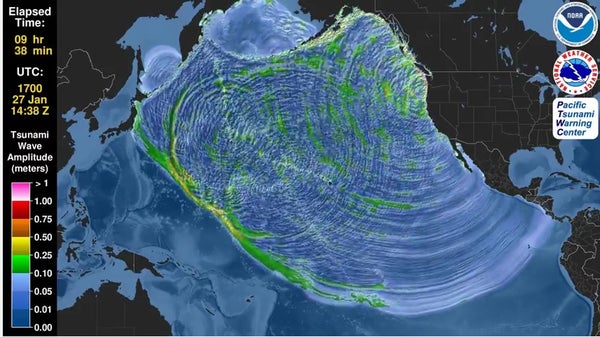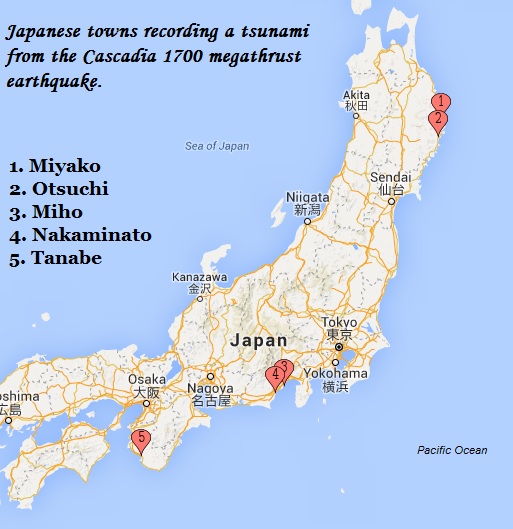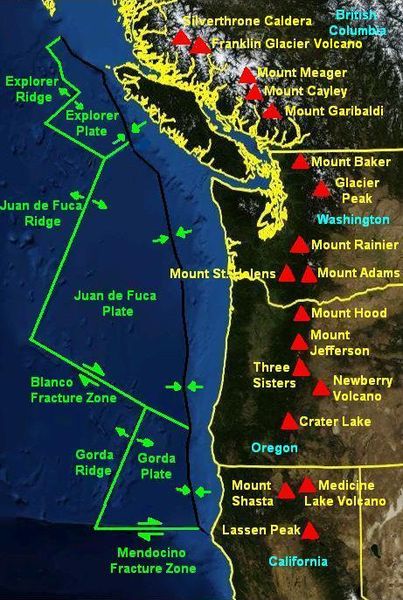This article was published in Scientific American’s former blog network and reflects the views of the author, not necessarily those of Scientific American
By most accounts, it was a dark and story night when Thunderbird and Whale fought their cataclysmic battle. Darkness comes early in the Pacific Northwest in January: the sun had been down for hours, and in the dark and cold, no one could see Thunderbird swoop down. But they felt it when she grabbed Whale in her talons, and rose up with it. Then she dropped Whale from a great height, slamming it into the ground. The land shook, and the waters receded. Some people knew to get into their canoes. Some didn't have time. And then came the great flood, which destroyed whole villages, and left many canoes stranded in the trees.
That's one version of what happened that night.
On supporting science journalism
If you're enjoying this article, consider supporting our award-winning journalism by subscribing. By purchasing a subscription you are helping to ensure the future of impactful stories about the discoveries and ideas shaping our world today.
There are many tales. In some, Thunderbird is the hero: in others, the villain. In some, she (or he) is fighting the virtuous/evil Whale; in others, the Transformer who creates or changes the world is her opponent. The two of them have fought many times. Their stories are told up and down the coast. They have changed the shape of the land. They have created and destroyed. And their most epic battles have shaken the earth, and then caused the ocean to roll over it. People are left floating in the sea in their canoes without a way to get home. Whole villages along the coast are razed. And the ones that survive are those nearer high ground, although some of the stories also tell of how the shaking caused whole mountainsides to come down, sometimes burying villages beneath them. From Vancouver Island to Northern California, variations in the story were told.
And many of them have enough details to be dated. When we do, we discover that they refer to one winter's night in the early 1700s.
But they're just stories. Myths. Right?
There are other stories about that night. Across the ocean, in Japan, January 26th, 1700 had been a nice day. Some places were cloudy, others sunny, with no major storms. No one was expecting disaster when they went to bed that night. And there was no shaking, no indication anything would happen, until the tsunami arrived at midnight.
It invaded towns along the coast, inexorable. The worst damage happened in the north. In the Miyako Bay area, where the tsunami probably reached a height of five meters, the floodwaters ripped apart or washed out thirteen houses in the town of Kuwagasaki as villagers fled to high ground. Twenty-one more houses burned in the ensuing fires.* Happily, everybody lived, and they would be able to rebuild when the fires were out and the waters receded.
Seven kilometers away in Tsugaruishi, houses along the shore were swept away. Floodwaters proceeded into town a kilometer inland from the bay, and the tsunami barreled up the Tsugaruishi River all the way to Kubota Crossing. Villagers panicked when it nearly reached Inarinoshita, just below Inari Shrine. But they and their shrine survived the night.
In Ōtsuchi, thirty kilometers south of Miyako Bay, the midnight tsunami damaged rice paddies and farmers' fields, along with two houses and two salt-evaporation kilns, but probably stopped just short of the town's main street. Officials reported that no people - or horses - were killed in the chaos. Hopefully other animals survived the night as well.
Further down the coast, the port town of Nakaminato suffered nothing of note on the night of the tsunami, although an official reported high waves preventing boat traffic from entering the port on the morning of the 28th - a result of the ebbing tsunami interacting with incoming ocean swells.
In Miho, the village headman woke to what appeared to be a series of brief high tides. The unusual waves worried him enough to send the village's elders and children to the high ground at Miho Shrine, and he kept a sharp eye on the sea. He was fascinated: he'd heard that tsunamis often followed earthquakes, but there had been no earthquake. He watched the bayside pine grove flood, and counted seven waves, and was disturbed enough by the highly unusual events to make a meticulous record of them.
The last district to report any damage or strange events was Tanabe, far to the south. The tsunami invaded the government storehouse in Shinjō, and astonished the mayor and other onlookers by reaching a castle moat near his house in Horidobashi. Seawater flooded fields in Atonoura, Mikonohama, and Mera. But here, as elsewhere, no one was killed.
None of the people astonished by the sudden tsunami ever learned what had caused it. Officials sent in their reports, damages were compensated, and life went on. The poor headman at Miho never had his curiosity satisfied. Other orphan tsunamis had happened both before and after, but by the end of the 20th century, most of them had been matched to their parent earthquake. But Japan's orphan tsunami of 1700 remained a mystery.
And then geologists along the Pacific Northwest coast began hearing stories of the night Thunderbird and Whale fought.
No one had thought much of the Cascadia Subduction Zone at first. Europeans had been kicking around it for centuries without recording the enormous earthquakes that regularly plagued other zones. The whole thing, stretching 80 kilometers offshore from the middle of Vancouver Island down to Northern California, seemed just as pacific as the ocean it was named for. Maybe if the Europeans who settled here hadn't decimated native populations, causing up to 95% of their oral history to be lost, more stories of Thunderbird and Whale would have survived. Maybe those stories would have caught everyone's attention sooner. After all, folks who had been living along this coast for thousands of years knew that every once in a while, the earth shook tremendously, and the sea flooded in, and people died. They encoded that knowledge in stories, and passed it along.
By the 1980s, geologists were beginning to suspect that Cascadia liked to get up to shenanigans, just like other subduction zones. After all, they'd seen that megathrust earthquakes, the kind that happen when one plate overrides another, tend to happen when relatively young, hot oceanic crust is diving beneath a continent. They were more common where subduction was fast (for geological values of "fast"), and Cascadia was slow. But its oceanic crust, created by the Juan de Fuca and Gorda ridges not far from shore, was extremely young and very, very hot.
And there were those stories, which sounded like legends, but also sounded very much like people describing a megathrust earthquake followed by a tsunami.
So, as scientists do, all the earth science folk got busy. Some of them found evidence for abrupt coastal subsidence and inundation by tsunamis along the CSZ. Others found enormous underwater landslides (turbedites) caused by huge earthquakes.† Geodesists using GPS to measure the plate movements between the Juan de Fuca and North American plates found them locked. Dear, oh dear. The thing apparently liked to go big when it moved.
Further research revealed that a nice, big megathrust earthquake had made parts of the coast subside, drowning entire forests. Various clues pointed to it being at least magnitude 8.7, perhaps even as large as a 9.2. Tree rings from four different estuaries all returned dates between August of 1699 and May of 1700.
And this is when the orphan tsunami becomes reunited with its parent earthquake. It could be none other. Only a few regions were possible as the source, and written records had already ruled out South America and Kamchatka. An earthquake along the Alaska-Aleutian subduction zone could send a tsunami Japan's way, but it was at the wrong angle to have caused one as large as the 1700 orphan. Only Cascadia had an earthquake at the right time, of the right size, in the right place.
That is the story of Thunderbird and the Orphan Tsunami. Like all good stories, it has lots of chaos and excitement, truth mixed with fantasy, and a moral. In this case, the moral is: be ready. You never know when Thunderbird and Whale will violently disagree, and when they fight, the effects can be felt across an entire ocean.
For an absolutely marvelous article about Cascadia and the native legends that helped tip us to its dangers, see The Great Quake and the Great Drowning by Ann Finkbeiner. I've tried to mostly fill in the bits she didn't have room for.
References:
Atwater et al (2015): The orphan tsunami of 1700—Japanese clues to a parent earthquake in North America. USGS Professional Paper 1707
Ludwin et al (2005): Dating the 1700 Cascadia Earthquake: Great Coastal Earthquakes in Native Stories. Seismological Research Letters, V. 76, No. 2
Satake et al (1996): Time and size of a giant earthquake in Cascadia inferred from Japanese tsunami records of January 1700. Nature 379 (6562), 246-249.
Satake, Kenji and Atwater, Brian F. (2007): Long-Term Perspectives on Giant Earthquakes and Tsunamis at Subduction Zones. Annual Review of Earth and Planetary Sciences Vol. 35: 349-374
*You don't often think of fire as a hazard of flood, but the water doesn't cover everything, and when all of your nighttime light and heat is provided by open flames, you do end up with the occasional conflagration.
†Dating those turbedites shows they happen every 500 years or so, on average. So we are not really "overdue" for a megathrust earthquake, even though one could happen at any time.


